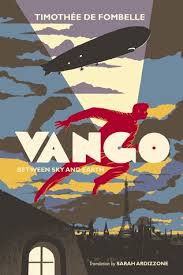Vango: Between Sky and Earth
- By Timothée de Fombelle; translated by Sarah Ardizzone
- Candlewick Press
- 432 pp.
- Reviewed by Caroline Bock
- February 12, 2015
This whirlwind of a YA tale takes readers around the globe.

Paris. Moscow. New York. London. The Aeolian Islands off Sicily. The Scottish Highlands. With breakneck speed, teenage readers will be transported into the whirling intrigue between the two World Wars with a fascinating new literary hero. Vango: Between Sky and Earth, by Timothée de Fombelle, is an exotic young-adult novel. Fombelle is an award-winning French author and playwright whose debut YA effort, Toby Alone, has been translated into 29 languages. His new work is certainly worthy of its crisp English translation.
The story opens in Paris near Notre Dame on a rainy day in April 1934. On what should be the most important day in his life, our protagonist, Vango Romano, is minutes away from taking his priestly vows when Police Superintendent Auguste Boulard advances through the crowd toward him. Shots are fired. Vango scales the cathedral, “choosing the way of the angels,” up the ramparts. And so begins his great adventure.
In this fast-paced novel, which at points jolts the reader back and forward in time and place, we soon learn that, as an infant, Vango was found on the rocks of Salina, a remote Sicilian island, with his caretaker, the gorgeous, mysterious, and multilingual Mademoiselle.
The world is staggering out of the ravages of the First World War and lurching toward the second when the orphan, perhaps a kind of savior, washes ashore. “Vango was no ordinary orphan. He was heir to a world that had been engulfed.” He represents the lost innocence of a world soon to be thrust back into conflict.
It is in this world that Vango befriends Zephiro, a rabbit-raising monk living in a hidden island monastery. However, Zephiro has his own secrets and is soon drawn out of his sanctuary to identify Voloy Victor, an antagonist pulled straight out of classic espionage movies, an agent from Stalin’s Soviet Union. Through his friendship with Zephiro, Vango becomes implicated in this misadventure of justice.
Yet Vango has an uncanny sense of balance. He can literally scale cliffs and rooftops, and he escapes from one adventure to the next. He knows what matters in the world: friends, love, being true to oneself.
Written in three parts and 33 chapters, Vango leaps between points of view, timeframes, and settings; it requires a close reading to keep track of everything. The novel takes Vango from the Aeolian Islands off Sicily to Paris to Lake Constance, Germany, to Moscow to New York City to Scotland before he can finally make it back home.
Turn the page and the reader encounters towering historic figures in familial settings: from Josef Stalin at home with his daughter Setanka to Dr. Hugo Eckener, creator of the Graf Zeppelin, who saves Vango and others from the Nazis’ grasp. In one of the novel’s many fine footnotes to history, also aboard the zeppelin is Lady Drummond-Hay, a real-life English aristocrat and reporter for the American Hearst newspapers, and the first woman to travel the globe in a zeppelin.
Fombelle’s Vango, like his French literary descendent, Voltaire’s Candide, comes of age when the world is on the brink of something new and dangerous, and there does seem to be a bit of satire at work as Vango continues to outwit the Soviets, the French police, and all others out to track him down. The modern world of zeppelins, fast-driving motorcars, paranoia, and turbulence fuels this adventure.
The world may be dangerous for Vango, but it also has its precious moments, and the book conveys a fine balance between the quixotic and the deadly serious. The novel’s epigram, from the French poet Rimbaud, foreshadows Vango’s adventures, declaring, “I have hung ropes from steeple to steeple; garlands from window to window; golden chains from star to star, and I dance.”
Ultimately, Vango should appeal to the teen who enjoys the historical fiction of writers such as Avi. However, all but the most devoted reader may get a bit tangled in the overlapping storylines and characters. Nevertheless, this reader cheers on Vango, an uncommon hero.
Caroline Bock is author of the critically acclaimed young-adult novels Before My Eyes and LIE.
